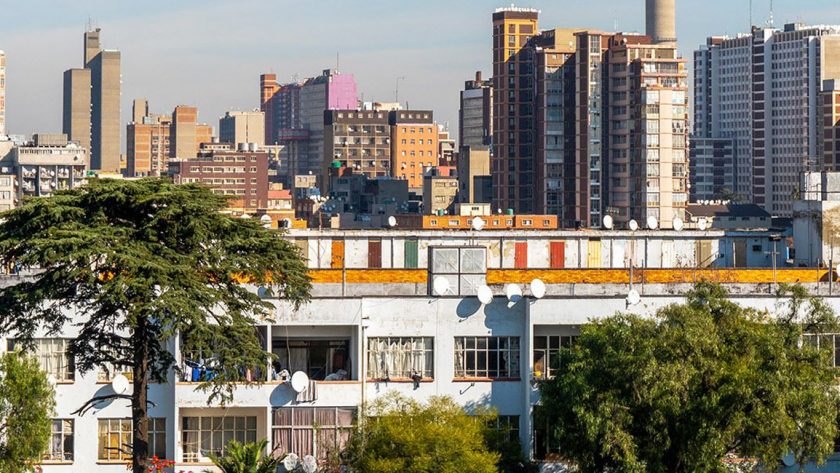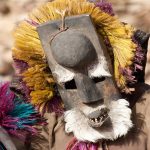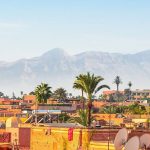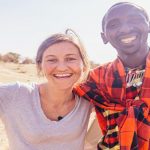The most interesting person I met in Johannesburg was a five-foot-one, 36-year-old white South African soldier-turned-tour operator named Brian. Over a six-egg omelet and a cup of tea late one morning, he recounted one amazing story after another. As he chained smoke through breakfast, he told me that he decided to carry his machine gun with him at all times since being mugged less than a week after his release from the army. He explained how, another time, he was caught in the middle of a bank robbery and killed all but one of the robbers.
“Did you go to jail? Were you arrested?” I asked. Brian looked insulted. He leaned forward. His voice took on a deadly serious tone as he looked me straight in the eye.
“I saved the bank thousands upon thousands of Rand, and did the cops’ job for them.”
He leaned back and sized me up. “I got charged with discharging a weapon in a public place, but the community and bank rallied behind me and, due to their support, the charges were dropped. The bank gave me a 21,000 Rand reward. ”
“You need to see the real Johannesburg, Mr. Steel,” he said smugly. His frown and wrinkled forehead showed no signs of pride in his declaration. He meant for me to see what a hell on earth Johannesburg truly was. So we made an arrangement. In a few days he would show me around, and I would pay him for it.
That afternoon a girl and three men came back to Brown Sugar; the hostel I had chosen. I met them the night before, a Dutch girl of about twenty, not pretty, two German lads of about the same age, and a deeply tanned Italian. I could see some of the color had drained from the Italian’s face. He was trembling slightly. The group shuffled over to the couches and recounted the day’s events. The four of them had been walking, single-file in an open-air pavilion in Hillbrow. The Italian was the last in line as they walked and suddenly found himself at the mercy of three men who had come from behind, one now held a blade to his throat. They stole his backpack and wallet and robbed him even of his watch and rings. Then, as quickly as they came, they had vanished into the crowd. The mugging had only taken a few seconds.
The day before I was to leave Jo’Berg (or “Crime-berg,” as it had come to be known to travelers), I took our machine-gunning friend up on his offer. He proceeded to drive, in silence, through the areas of Johannesburg that have some of the worst crime rates in the world. As he reached across and locked my door, he said that everyone we were seeing on the streets was a pimp, dealer, junkie, prostitute or gangster. There was razor wire around almost all of the buildings, dwellings, and storefronts. There were no trees, flowers or grassy areas anywhere in the city.
We continued towards the poorest ghetto: Soweto. The “better” areas of Soweto consisted mostly of shacks of tin. There was the occasional one or two room brick structure about the size of a one-car garage in the States. We drove to an exhibit and memorial site that commemorated the student uprising of 1976 that marked the beginning of the end of apartheid in South Africa. The museum consisted of four open freight train containers exhibiting photographs of the Soweto uprising.
We moved on until Kliptown – the worst of the worst of the Soweto ghettos. We drove past tents made of sticks covered by scrap cloth, stalls made of discarded wood and branches, erected by the side of the road in efforts to sell fruit to anyone who had the misfortune to have to travel this route. All the black residents were staring at us as we drove into the ghetto, their eyes haunting us as they studied our clean clothes, cameras, and backpacks.
Brian introduced us to Bob Nameng, a Soweto local who proudly displayed his seven-year-old dreadlocks. He was a very talkative and amazingly positive young man, considering his surroundings. I felt instantly at ease in his company. I was to find out later that there are no “tours” that let one out of the car in any area of Soweto at anytime. As I walked through Kliptown with Bob I saw shacks made of scrap tin siding, boards, cloth and dirty cardboard. All had low ceilings, enough so that one had to duck even when inside. There was no running water, no electricity, nothing. We met some black children clothed in old rags, no shoes, nothing. I watched them play as children do, laughing, smiling, and sharing the one toy that they had; a bent metal bar with two wheels attached that could be used as a makeshift wagon. They took turns rolling each other along the dirt, laughing hysterically when one of the wheels would give and they both went tumbling.
Bob was the closest thing to a mayor that this town had. He quoted some shocking statistics to us as boys and girls passed by returning home from school.
“These young women,” he said, of the students passing us. “One in three of them will experience her first sexual experience through rape. Also the incidence of AIDS is higher here than anywhere else on the planet. Of the world’s 34 million cases, seventy per cent occur in Sub- Saharan Africa, and our government turns a blind eye to our community.”
We later found out that he organized all of the community programs, including AIDS awareness, child abuse and rape prevention programs, a shelter for the neglected, charity collection, youth plays, soccer teams and even beauty pageants. He ran all these programs out of the back of an old tire-repair shop. Bob showed us his library, of which he was especially proud. It actually was a collection of 20 or so used books stacked in an old tire rack. He provided beds for children who needed to spend a few nights away from abusive parents, offering two rooms with old dirty cushions on the floor. We met Gordon, Tabo and Robert in this center, all community volunteers who worked with Bob. They walked us through their community; between dirty shacks, under clothes lines, over open streams of sewer water and through back alleys as they described what they hoped for their community.
There was a lot of activity in the streets and Bob seemed to know everyone. Old women wrapped in shawls, despite the heat, waved and shouted greetings to him. Teenagers high-fived him as we walked by and children were constantly running up to him as one would a favorite uncle. Through all the poverty and filth, the dirt, depression, maimed and deformed, the shantytown shacks, the hungry and abused, Bob somehow made it seem not so grim. Every time he told or showed me something horrible or devastating, he also let me know how he was trying to improve it. Walking with these four young black South Africans through Kliptown; the worst slum in Soweto, supposedly the most dangerous place in South Africa, I felt more at ease than I had on any of my travels.
I found out later that there were other, “official” tours of Soweto that people could buy. The tour companies offered to cart tourists around in air-conditioned vans that they never had to step out of, and take them to the schools outside Johannesburg, but in the wealthier areas of Soweto. There, tourists could observe children learning in the newly constructed schools and even help out by reading to a primary school child during recess. There were brochures printed up with glossy pictures of the ghetto children in starched school uniforms with quotes like “make a difference” and other patronizing statements. The brochures even encouraged tourists to bring sweets for the children. Little would they know how little of Soweto they would experience from inside their comfortable vans, yet would leave Africa feeling as though they had seen the worst of the worst. But they hadn’t met Bob Nameng, and seen the best of Soweto.
These few snapshots represent only a few of the tiles that make up the mosaic that is South Africa. It takes reflection and time, once one has finished the trip to step back and see the entire journey, the whole picture. It is easy to conjure up specific images, especially dramatic moments that punctuate one’s adventure. But is much more difficult to blur these moments into a kaleidoscopic image that evokes an overall feel for South Africa. My South African journey exists as my greatest adventure. The country is a living paradox and I am grateful for having had the privilege to see so many sides of this diverse, vibrant country.



